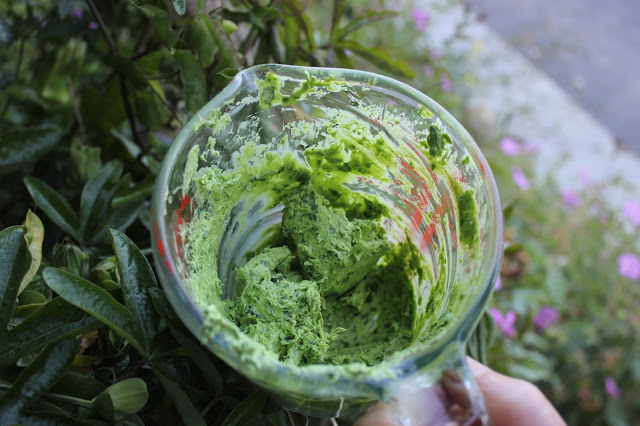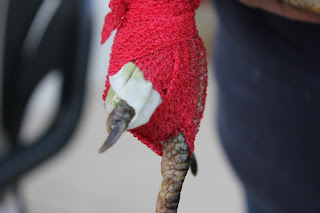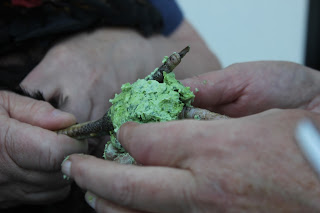I first used a cabbage poultice some ten years ago on one of my serial broody hens, Lucky. She was always sitting with or without eggs and often with some results she probably didn't count on, see below! After one particularly long period of being broody in which she sat with, or rather partially wedged underneath, three other hens, I noticed she developed a limp. When she came off the nest she began to lift her one leg off the ground and hold it tightly in a ball, as if some involuntary nerve spasm was forcing this to happen.
As I could find nothing obviously wrong with her foot or leg, I asked the advice of a friend of mine, an organic dairy farmer, who as part of her continuing education had spent several months shadowing an organic vet. She suggested Lucky might have a constriction in her leg caused by a swelling on her 'knee' and it was true she did have what seemed the very slightest evidence of scaly leg mite in this area. My friend Marie-Agnès suggested that I tried a cabbage poultice, traditionally used here in France for many conditions including inflammation due to sprains, strains and cancers. I put a poultice on Lucky over the following five nights it was so successful I have always kept part of the ingredients 'on ice' and ready just in case.
Recently I had occasion to use this poultice again on two cases which turned up simultaneously, one of my quail, Drusilla injured her foot and my neighbour's hen had a case of suspected bumblefoot. As I already mentioned before, one of the ingredients I always have in stock in the freezer. This is organic pig's lard which I rendered down from trimmings given to me freely by our organic butcher. It might be an idea, if you have one near you to ask, as I do find this type of fat very suitable as a carrier for making any kind of poultice. I have, at a pinch also used coconut oil but it melts very quickly particularly on a hot foot, whereas the lard keeps its form for longer.
This poultice keeps very well in a cool place, so you can make enough for five treatments at a time. Just consider when preparing it that it is the cabbage that is the active ingredient so you need by volume more of it than the fat.
Brassicas - Anti-inflammatory and Anti-microbial Properties
Cabbage contains several anti-inflammatory nutrients, including:
- anthocyanins (flavenoids which make the red/blue pigment in fruit and vegetables) these are obviously more prevalent in red cabbage,
- polyphenols (antioxidants) present in abundance in all kinds of cabbage and
- the amino acid L-glutamine.
Cabbage also contains:
- the glucosinolate, sinigrin, which has anti-microbial properties. The Savoy cabbage I use is the one with a higher proportion of sinigrin, which is also prevalent in the seeds of another brassica, black mustard and was used historically in medicine as a 'mustard plaster'. Sinigrin is now being looked at in relation to cancer prevention and treatment, in particular colon, bladder and prostate cancers. Research published in 2014 also highlighted the potential of sinigrin as an anti-cancer agent for liver cancer.
Above - my neighbour's hen with swelling to the metatarsal pad of her foot.
Timing
The best time to put a poultice on poultry is at night, cabbage poultices, particularly when made with a delicious organic fat can be very interesting to a bird, even one who has just dined. I like to put the poultice on and then put the patient to bed in a cardboard box in the dark. In the morning I get the poultice off early so the patient doesn't have time to investigate, start to unravel and/or eat the poultice. A cabbage poultice has the ability to withdraw toxins, so it's best not to let the bird get a chance of eating it. However, with the very professional vet bandage (above) we did make an exception as there was no way my neighbour's hen could break into it!
Ingredients and Materials
Several large leaves of organic cabbage, I like to use Savoy but I have used red cabbage too.
A walnut-sized piece of pig's lard
Organic cotton wool (25% of the World's pesticides are used in the production of cotton)
A bandage, or in my case remnant strips of organic fabric or old organic tee shirts!
Method
Chop cabbage roughly and then dice using a stick blender or liquidiser.
Add fat and make it into a smooth green paste. You can obviously do this all by hand but you will need to chop the cabbage very finely to extract the maximum amount of juice to be carried by the fat.
Add fat and make it into a smooth green paste. You can obviously do this all by hand but you will need to chop the cabbage very finely to extract the maximum amount of juice to be carried by the fat.
Liberally spread over affected area, I like to make it about 1cm (½") thick.
Cover with cotton wool, paying particular attention, when treating a foot as in this case (right) to the area between the claws, this helps to keep the whole preparation together whilst getting ready for the final bandage.
My neighbour works for the local vet so she had some very professional-looking additional stretch wrappings!
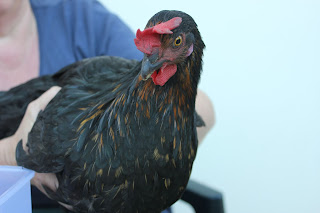 As I mentioned above, I put a fresh poultice on each night for five nights and this brought down the swelling on both Lucky and my quail. For my neighbour's hen, the swelling came down to reveal the tell-tale black 'scar' of bumblefoot, so we applied one drop of Tea Tree essential oil dissolved in one teaspoon of coconut oil evening and morning for five days, when the scar opened up and the hard pad of infection came out of its own accord. My neighbour then went on to disinfect the area further and bandage it up.
As I mentioned above, I put a fresh poultice on each night for five nights and this brought down the swelling on both Lucky and my quail. For my neighbour's hen, the swelling came down to reveal the tell-tale black 'scar' of bumblefoot, so we applied one drop of Tea Tree essential oil dissolved in one teaspoon of coconut oil evening and morning for five days, when the scar opened up and the hard pad of infection came out of its own accord. My neighbour then went on to disinfect the area further and bandage it up.I further complemented the treatment for my injured quail with nutritional support and the article in which I discuss this can be accessed below via the 'read more' live link.
If you have enjoyed this
piece and found it
useful think about sharing it with your family and friends, on social
media and also maybe about joining this blog
and/or subscribing to my Youtube channel or even supporting us on
Patreon or Please
also feel free to ask questions.
All the very best,
Sue
RELATED POSTS
Treating an injured quail Nutritional support for sprains, strains and nerve damage
Here's Drusilla she is one of my coturnix quail and over the past few
days she has started to limp, holding up her foot and hopping...read more
Treating a nasty head wound and shock
Our poor quail, Nuggets with a horrible injury to her head and eyes (Happy ending!) ...read more
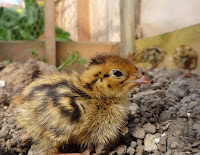 Identification of riboflavin deficiency in purchased quail and hatching eggs
Identification of riboflavin deficiency in purchased quail and hatching eggs
Quail have a high basal metabolic rate and as such their problems with nutrition are dramatically and rapidly revealed...read more
 Cure curled toe paralysis (riboflavin deficiency)
Cure curled toe paralysis (riboflavin deficiency)
For my 'field study', I am using the example of quail chicks, from
non-organic purchased hatching eggs because this is the area in which,
sadly I have a great deal of experience ..read more
RETURN TO CONTENTS PAGE
© Sue Cross 2016



